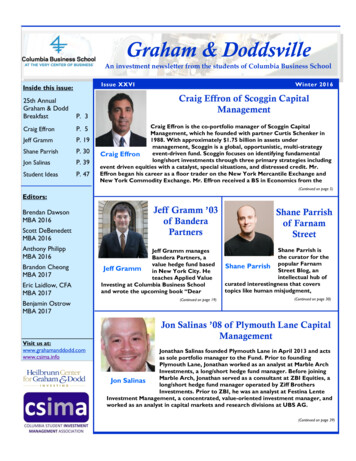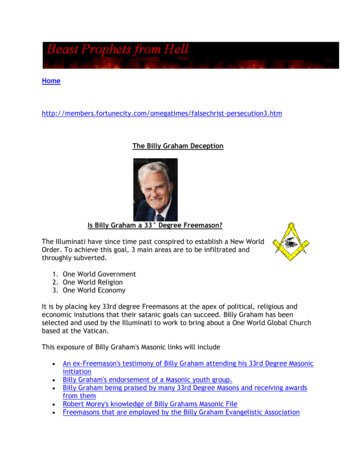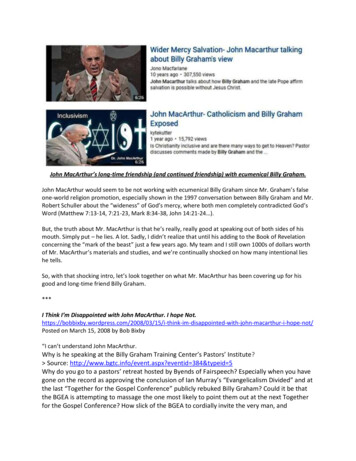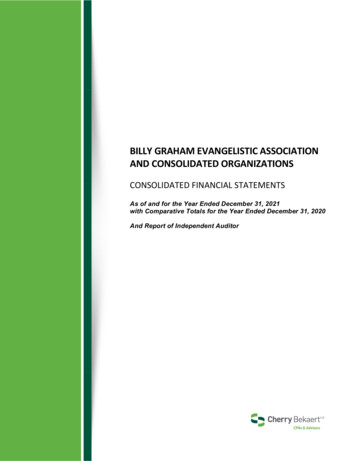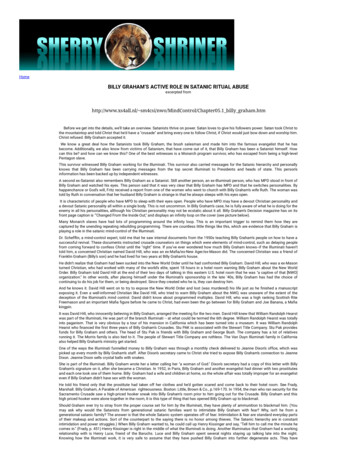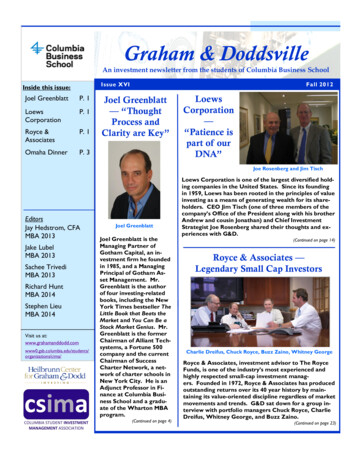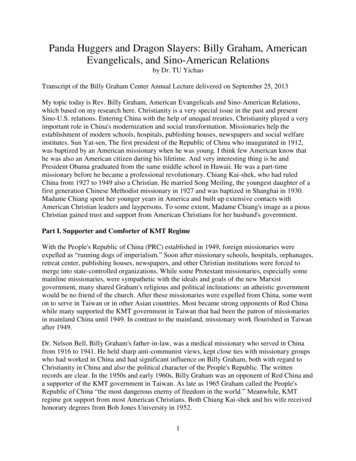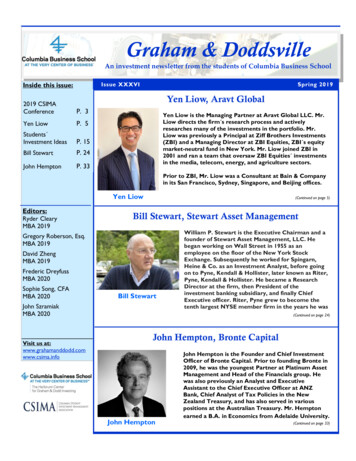
Transcription
Graham & DoddsvilleAn investment newsletter from the students of Columbia Business SchoolIssue XXXVIInside this issue:Spring 2019Yen Liow, Aravt Global2019 CSIMAConferenceP. 3Yen LiowP. 5Students Investment IdeasP. 15Bill StewartP. 24John HemptonP. 33Yen Liow is the Managing Partner at Aravt Global LLC. Mr.Liow directs the firm s research process and activelyresearches many of the investments in the portfolio. Mr.Liow was previously a Principal at Ziff Brothers Investments(ZBI) and a Managing Director at ZBI Equities, ZBI s equitymarket-neutral fund in New York. Mr. Liow joined ZBI in2001 and ran a team that oversaw ZBI Equities investmentsin the media, telecom, energy, and agriculture sectors.Prior to ZBI, Mr. Liow was a Consultant at Bain & Companyin its San Francisco, Sydney, Singapore, and Beijing offices.Yen LiowEditors:Ryder ClearyMBA 2019(Continued on page 5)Bill Stewart, Stewart Asset ManagementGregory Roberson, Esq.MBA 2019David ZhengMBA 2019Frederic DreyfussMBA 2020Sophie Song, CFAMBA 2020Bill StewartJohn SzramiakMBA 2020Visit us at:www.grahamanddodd.comwww.csima.infoWilliam P. Stewart is the Executive Chairman and afounder of Stewart Asset Management, LLC. Hebegan working on Wall Street in 1955 as anemployee on the floor of the New York StockExchange. Subsequently he worked for Spingarn,Heine & Co. as an Investment Analyst, before goingon to Pyne, Kendall & Hollister, later known as Riter,Pyne, Kendall & Hollister. He became a ResearchDirector at the firm, then President of theinvestment banking subsidiary, and finally ChiefExecutive officer. Riter, Pyne grew to become thetenth largest NYSE member firm in the years he was(Continued on page 24)John Hempton, Bronte CapitalJohn Hempton isRolfthe HeitmeyerFounder and Chief InvestmentOfficer of Bronte Capital. Prior to founding Bronte in2009, he was the youngest Partner at Platinum AssetManagement and Head of the Financials group. Hewas also previously an Analyst and ExecutiveAssistant to the Chief Executive Officer at ANZBank, Chief Analyst of Tax Policies in the NewZealand Treasury, and has also served in variouspositions at the Australian Treasury. Mr. Hemptonearned a B.A. in Economics from Adelaide University.John Hempton(Continued on page 33)
Page 24Bill Stewart, Stewart Asset Management(Continued from page 1)there. The firm was soldin 1973. He joined RuaneCunniff and Stires as ViceChairman.Bill StewartIn 1974 he founded W.P.Stewart & Company as abroker dealer andinvestment advisor, whichbecame a publicly tradedcompany on the New YorkStock Exchange in 2000.At the time it went public,the firm had 12 billion inassets under managementin separate accounts, aswell as US and Europeanregistered mutual funds.From the firm s foundingin 1974 to 2013, the year inwhich the firm wasacquired byAllianceBernstein L.P.,W.P. Stewart & Co.outperformed the S&P 500Index by an average of 430basis points annually, netof fees.After the sale of W.P.Stewart & Co. toAllianceBernstein in 2013,Bill formed WPS AdvisorsLtd., a Bermuda company.A group of analysts wasassembled to pursue aninvestment philosophysimilar to the one thatearned Bill s clients over16% a year after fees forthe 38-year history of W.P.Stewart and Co. The newbusiness was domesticatedto the US in 2017, asStewart AssetManagement, LLC, an SECRegistered InvestmentAdvisor. Over the four anda half years since itsinception, the new firm hascontinued to grow itsclients portfolios at a rateslightly faster than itspredecessor did. Initialclients of the new firmhave now more thandoubled their investment.hence I figured I ought to learnsomething about this industry.Graham & Doddsville(G&D): Could you tell usabout your background andhow you got into investing?I started going to night schoolin the city instead of attendingthe University of Maine. I wentthrough various floor positionsat the Exchange, starteddeveloping a business, andbecame a broker on my 21stbirthday. I learned enoughabout research to go out andstart seeing companies, visitingmanagement, doingspreadsheets, and writing upreports on stocks I liked. I wasselling these ideas to dentists,pharmacists and furnituredealers.Bill Stewart (BS): I got intoinvestment management byaccident. I initially took atemporary job on the floor ofthe New York Stock Exchangeas a page boy in 1955 while Iwas waiting to start college atthe University of Maine. Itturned out that I liked what Isaw on the floor and I decidedthat I should learn thatbusiness. At the time, I wasplanning to be a Forest Rangerand had no interest ininvesting. But after watchingthe money being made bysmart investors, I decided thatif I played it right, I could buymy own forest. In time, alongwith others, I was eventuallyable to buy several of them aswell as a farm and turn themover to conservation groups tomanage in perpetuity.G&D: What was it about yourtime as a page that made yourealize this was the industryyou wanted to be in?BS: It was a time you probablycan t even imagine. Therewere no phones on the openfloor, let alone cell phones,because no electroniccommunication was permitted.There were telephones aroundthe rim of the floor, butnothing in the middle, nothingat the posts. If you wanted todo serious trading, you had tophysically be on the floor tosee your counterparts and dealwith them directly. I saw somesmart guys doing things Ithought were interesting, whilemaking a lot of money at it;The market environment wasrelatively quiet. IBM was thestock of the decade, growingat 14% a year and trading at 50times earnings, the averageratio for good quality growthat the time. Many companieswere growing at 7% per annumand trading at around 25 timesearnings, much higher thantoday. IBM was at the top ofthe list of what we consideredhigh-quality growth companies,along with National CashRegister, American HomeProducts, Merck, Pfizer,Abbott and General Foods.This was around the timewhen Ben Graham said that hewould only invest in highquality growth companies if hecould, but generally speakingthey were too expensive, andhe d have to amortize a lot ofP/E ratio. He took a 7-yearlook, and if he envisioned amarket multiple of 17 in theterminal year and was paying50 times up front, amortizingthat was too big a headwind.So, he concentrated on whatcame to be called value stocks.(Continued on page 25)
Page 25Bill Stewart, Stewart Asset ManagementGraham published a formulawith his idea of fair P/E ratiosrelative to underlying growthrates: 8.5 twice the futuregrowth rate. I began to lookfor companies that werepriced below hisrecommended levels and triedto work out for myself whatconstituted an appropriate P/Eratio. My Security Analysiscourse at the New YorkInstitute of Finance was taughtby one of Graham s partnersat Graham-Newman, and hewas basically teaching Graham& Dodd s philosophy. I tookhis teachings to heart andstarted building out a veryconcentrated portfolio ofcompanies, only eight differentbusinesses, albeit in differentindustries to provide somediversification.G&D: Is that portfolioconstruction still what you retrying to attain?BS: Roughly 5-10 years afterthat first portfolio, I realized Ineeded to have a biggerinvestment universe. Having aportfolio of eight companies ismaybe a little bit tooconcentrated, so we increasedour portfolio size to 15-20companies. In fact, we still have15-20 stocks in our clients portfolios today, consistentwith what we ve done formore than 40 years.I adopted a value approach, butone that requires highlypredictable earnings growth,with the goal of having a veryconcentrated portfolio withaggregate earnings that go upevery year. That means that ifyou pay too much, it still getscheaper next year. That s ourhedge. In a cyclical, you neverknow when the next cycle willoccur, and you can be out ofphase for a long period oftime.Going back over 50 years,we ve never had a sharp fall inearnings power behind ourclients portfolios - whatBuffett calls “look-through”earnings. Our portfolio provedto be much less cyclical thanthe S&P 500, for which theannual rate of earnings change,up or down, can be verydramatic. The look-throughearning power growth behindour clients managed accountshas averaged about 15% a yearfor over 40 years now and hasnever declined. That earningsgrowth drives performance inthe long run.“At the time, I wasplanning to be aForest Ranger andhad no interest ininvesting. But afterwatching the moneybeing made by smartinvestors, I decidedthat if I played itright, I could buy myown forest.”Our goal has always been todouble our clients moneyevery five years, which iscompounding at a little lessthan 15% a year and we vedone that since we ve been inbusiness. At my old firm, weended up with an average of16.2% appreciation per annumafter fees for 38 years. As oflast week, we were at 16.3%growth per annum, net of fees,since we started Stewart AssetManagement four-and-a-halfyears ago. Our initial clients inthe new firm have already justabout doubled their capital.G&D: Was there anything inparticular that convinced youthat predictable earningsgrowth was the way youwanted to look at investing?BS: When I first started out, Itook lots of courses onanalysis and accounting andthought I could find greatvalue. Some things worked butother things didn t – and Ireally disliked the ones thatdidn t work. Earnings shortfallswere almost always the reasonan investment didn t work out.Everything we do wheninvesting people s capital isbased on compounding. Thewhole reason for being in theinvestment world is tocompound money. We allknow that 7% per annumdoubles in about 10 years and15% a year more than doublesin five years. I want that magicworking for me all the time.The thing that screws upcompounding is down years. Inorder to harnesscompounding, I wanted tomake sure I didn t have thosedown years in earnings. Thereare only two variables in thisbusiness: future earning powerand future P/E ratio. I believedand still believe that we can geta pretty good handle on futureearning power in a very limitednumber of leading businesses.P/E ratios are considerablymore volatile and tougher toaccurately forecast – thoughwe try. In all 38 years at mylast firm, W. P. Stewart & Co.,we had about 15% to 16%compounded growth per(Continued on page 26)
Page 26Bill Stewart, Stewart Asset Managementannum in underlying earningspower, basically more thandoubling every five years. Theafter-fee rate of return for ourportfolio was similar. Theperformance of the portfoliofollowed the performance ofearnings; to be sure, theyweren t the same in every yearbecause they can get out ofwhack with each other, butover the long run that s whatit averaged out to.This method works, and it s asimple one. First, you find asmall group of great companiesand get to know them very,very well. Then, you evaluatethem. We have a strictappraisal system and weforecast earnings over fiveyears. For 99% of the publiccompanies, you can t do thatvery well because they re veryvolatile, but a few of them arepretty predictable. Thesecompanies typically have acommanding position in theirmarkets and showcase greatprofitability as well as a highdegree of predictability. Theyalso have great management indepth and wonderful balancesheets. When a business meetsthese criteria, you can startappraising value five years out.Once we find a business thatwe like with predictableearnings growth, we ll thenwork with the spreadsheets.We use all our qualitativework and interviews withmanagement to try to estimateearnings in five years time, aswell as the terminal growthrate. We then evaluate aprospective premium ordiscount versus the market asa whole, for which we alsoforecast a multiple. Right now,it s an easy 17x, in line withthe historical average andprobably a little lower than itshould be with the low interestrates we have today. If we saya company is going to beworth a 30% premium, we lluse a 22x multiple in themodel in the terminal year, andthen discount the resultingvalue, plus accrued dividends,back to present value. Wediscount at 8% to 10% even ifthe Treasury market yields lessthan 3%. So that s probablytoo high a discount rate. Butthat s a margin of safety and itgoes back to Graham andDodd. You want a margin ofsafety in everything you do.“Everything we dowhen investing people scapital is based oncompounding. Thewhole reason for beingin the investment worldis to compoundmoney.”We then want to buy stockswell below their fair presentvalue as a further cushion. Thisis not a science but more of aguessing game. We try tomake the best guesses we can,but you need those cushions.G&D: Can you go into moredetail on what you call theappraisal system? When you redigging into a company, whatdoes it look like?BS: You might start out withthe addressable market, thenget to how many units acompany will sell, what thevalue per unit is, and what themargins are going to be.Ultimately you build a five-yearmodel and come up with a finalearnings power projection. Itcomes down to earning powerper share.We then take a marketmultiple and, because ourcompanies typically grow twiceas fast as the overall market,are market leaders, have greatbalance sheets, and haveoutstanding managementteams, we ll come up with apremium multiple. In a fewcases there might be adiscount, but generallyspeaking it s a premium.Mathematically, if a company isgrowing twice as fast as themarket, the near-term P/Emultiple premium amortizesvery quickly because theearnings grow.Typically, we ve been givingthe growth businesses weinvest in a 10% to 50%premium to the market,depending upon how well wethink things are going to go forthat company five years fromnow. I guess the highestterminal multiple we have is26x for Amazon, in five years.It s currently at about 60x ouridea of current capitalizableearning power.G&D: In terms of earningspredictability, how do youanalyze a company likeAmazon, which five years agolooked much different thanwhat it does today?BS: Obviously, Amazon WebServices is huge and is themost profitable division now.These situations are dynamic,so you make the best guessyou can and try to be more onthe conservative side whenfiguring out what all thesethings are likely to be worth,but the lovely part about a(Continued on page 27)
Page 27Bill Stewart, Stewart Asset Managementmodel is that it s not fixed. Itmay be a five-year model, butyou can change it every day.What you re really doing islaying out your decision treeand adjusting it. You can comeback saying, I think I got this alittle high, or that a little low.It s not fixed. In essence,we re always operating withthe best guess we can make. Ifit changes weekly, it changesweekly. It doesn t usuallychange weekly, but it could.Nobody s got a lock on what sright, a model is only a modeland it s not fixed in stone.Sometimes, nothing s changedbut you changed your mind.That s good. The purpose ofthe process is to bring out ourbest guesses. Everything we dois guessing. I think we all get alittle carried away with thescience of the matter, becausethere are lots of formulas,whereas you re essentiallymaking a guess.BS: Absolutely. For example,take the retailing section,which is huge, but where themargin is only about 7%. Formarketplace products sold by3rd parties, they don t take inthe sales price of the productssold, but they record theircommission on the sale, whichstarts out at 100% gross profit.That business is booming forthem. Now they invest a lot ofit away, but you have to tryand make an assumption aboutactual future earnings power.“Frank [Rooney] wasone of the greatretailers and I learneda lot from him. We ddrive around thecountry, go into theparking lot of aIn essence, we re looking atinvestment opportunities as abusinessman would look atthem. We re thinking aboutbuying a business today for 100 million and figuring outwhether or not we could sell itfor 200 million five yearslater. We make reasonablyconservative guesses, and asI ve mentioned we havesucceeded in growing lookthrough earnings behind ourclients portfolios every singleyear. That s very important.We try to have one of the twobig variables reasonably undercontrol.G&D: Coming back toAmazon, are there certainassumptions that you and yourteam think about in terms ofwhat the company will looklike in five years?shopping center, andhe could tell me theaverage annualincome of the peoplewho shopped therejust by the size of thegrease spots in theparking lot.”Web Services is another bigoperation as we discussed, andthey re also getting intoretailing with their own stores,which may, in effect be minidistribution centers. It s verydynamic, which is one reasonwhy we still assign Amazon arelatively high multiple of 26xin year 5 which, by the way,isn t really that high. We havecapitalizable earnings per shareof a bit more than 140 in themodel s terminal year, 2024. Aterminal multiple of 26x givesus a price that, discountedback at 9%, yields a presentvalue of 2,250. That s whyit s our largest position andhas been for a long time.MasterCard is our secondlargest position and, includingat my old firm, we ve ownedMasterCard since they wentpublic.G&D: Before we go intoindividual positions, can youtalk more about your analyticalprocess and the way you makeassumptions? Do you haveanalysts by sector in your firm?BS: We have 5 investmentpeople, excluding me, and wealways have a team of two oneach investment: one doesprimary coverage, and anotheris the backup, to ensurecontinuity. We have a smalloperation, but it works. Eachanalyst is a generalist and isgetting out there askingquestions, visiting management,digging around.G&D: You ran a firm for 38years before this and now youhave this new firm, which isonly four and a half years old.Can you talk about whatprompted the change?BS: I had partly retired fromthe old firm in 2001 and thenfully retired in 2004. Yet, by2007 the new managementwas having some problems andthe board asked me to comeback. Initially I didn t want to,but I did come back and stayedwith them untilAllianceBernstein purchasedthe company in 2013, which(Continued on page 28)
Page 28Bill Stewart, Stewart Asset Managementwas probably the appropriatething to do. They seem to behappy at AB.After the sale, I wanted to goback to retirement, which I didfor a few months. Then theformer CEO of W. P. Stewart& Co. and I thought we mightstart a new investmentmanager. I love being in themarket trying to figure outwhat s happening next ; butthese very smart young peopleat Stewart Asset Managementare doing the heavy lifting now,not me.G&D: How important ismanagement when it comes tolooking at a stock?BS: Ben Graham always said“don t count managementtwice”. The projected numberswill reflect the management sperformance, which means youdon t have to re-evaluatemanagement.That being said, I learned as ayoung analyst that managementis not a given. It s dynamic.The management teamchanges, individuals change,policies and procedureschange, unforeseen challengesdevelop, opportunities occur. Ithink you ve got to lookpeople in the eyes, talk tothem, and get a feel for theirpersonality. To me, investing isall about people. Goodmanagers doing a great job. Iwant to know thatmanagement is going toachieve its plan, and I need tomake a judgment on that.There are people you end uptrusting and other people who,when you walk out of theiroffices, the hair on the back ofyour neck is standing up. Ithink good management isvital.You don t put an extra pointon or take a point off, butmanagement gives youconviction. We always askourselves “Do we want to bein this business?” Coming backto what I already said, whenyou re investing you have tothink as a businessman buying abusiness, and then ask yourself“Do I want to be in thisbusiness with these people?Did they seem like they ve gottheir heads screwed on right?Are they long-term thinkers orare they opportunists?” That sthe type of thing you want toknow. Then, if the questionsare answered positively andyou want to be in this businesswith these people, you end upasking if you want to be in thisbusiness with these people atthis price? You apply the wholeappraisal process and get toyour discounted present value– what Graham used to call“fair value,” a price that ashare seems likely to sell at onthe way up or down within areasonable period of time.This process is very differentthan the one from the typicalvalue shop, where you reprimarily looking at the balancesheet and underlying earningpower. They re often seeking adiscount to tangible value,which is also a very valid wayto play. Such shops usuallyhave a huge number of stocksand use good theory ingeneral, so if they re wrong onsome names it averages out.We take the opposite point ofview. We have a very narrowly-focused portfolio where wehave to be right more often.Sticking with really fine,particularly well-managedbusinesses helps us do that.G&D: Are there any instanceswhere you had conviction in amanagement team and it justdidn t work out?BS: Oh, sure. I m alwaystelling our guys, success in thisbusiness is three steps forwardand two steps back. You don tjust keep marching on in astraight line, althoughthankfully we ve had far moresuccesses than failures.G&D: How long do youtypically hold an investmentfor?BS: My horizon is 10 to 15years on average, and at least 5years. We held major positionsin retailing for the better partof 20 years - great growthbusinesses like Walmart andHome Depot in their dynamicgrowth years. My best everwould be Melville Corporation:26 years at 26% per annum. Itwas phenomenal.Melville went from a little shoechain headquartered in NewYork to becoming the 10thlargest retailer in America.That was a great story. Myinterest started when I saw anarticle in the Times sayingFrank Rooney had beenappointed President of Melville.I knew it was a sleepy shoeretailer and the only thing ithad going for it was its strongbalance sheet. I called Frank tocongratulate him on his newjob but also asked him “Whatis a smart Wharton Schoolgraduate like you doing at acrummy old shoe company?”He said, “Well come on upand I ll tell you.” They hadtheir office in MidtownManhattan. I got in a cab andwent over there, and heexplained to me how shoppingcenters were pushing MainStreet off the map and wouldgo up all over this country.(Continued on page 29)
Page 29Bill Stewart, Stewart Asset ManagementFrank already knew that Saks,JCPenney, Sears and the likeswould become the anchors inthese centers. But nobodydominated the space betweenthe anchors yet.So, he figured, if he couldcontrol a shoe company, thatwould be a good place to start,because everybody needs tohave shoes. Eventually, his goalwas to dominate the spacebetween the anchors likenobody else had done, andthrough multiple acquisitions,including chains like CVS andMarshalls, and fast storegrowth, he did it.G&D: At what point did yousell your position in Melville?BS: I sold my position in 1972,having held it for about 11 or12 years. It went to 40 timesearnings and I felt it was tooexpensive. I wrote a reportsaying I loved the company butthe price was too rich. Andthen it fell down to about 12or 15, during the big crash in1974 and it briefly dropped to 5 a share. We bought back alot more stock and then itwent to the hundreds fromthere.Frank retired at 65, followingthe institution of a rule defining65 as the mandatoryretirement age that heestablished 20 years earlier. Atthat point, we sold all of ourstock. Frank, by the way, wenton to work for Warren Buffettfor the next 18 years or so. Icalled to congratulate him onhis 80th birthday and he said,“You know what Warren justgave me for my birthday? Anew 20-year contract.”Frank was one of the greatretailers and I learned a lotfrom him. We d drive aroundthe country, go into theparking lot of a shoppingcenter, and he could tell methe average annual income ofthe people who shoppedthere, just by the size of thegrease spots in the parking lot.G&D: Do you have an opinionon the future of brick-andmortar retailing?BS: Brick-and-mortar retail isgradually declining. Yet, I mlooking for the next thingthat s going to happen. On onehand, some shopping centerdevelopers are putting medicalcenters in, and other thingslike that, which I think isworking well. Some retailersare developing stores as minidistribution centers as part ofthe evolving omni-channeltrend.On the other hand, you areseeing some disrupters, likeRestoration Hardware. Theyare creating stores that attractyou. You want to go therebecause, for example, they vegot a restaurant and people toshow you how to decorateyour home. People go there asa destination, and they can tget that from Amazon. BestBuy is becoming anotherdestination store. Both areomni-channel operators.Restoration Hardware is doingwell and growing very nicely.Our guys here are taking alook at it and are planninganother visit with the companynext week. It seems they aretrying to do somethingdifferent. They ve openedmaybe a couple dozen storesaround the country, which areattracting people from a widearea. It s a destination. You gothere, drive there, spendseveral hours and have lunch.It might work, I don t know.The CEO has a vision and Iwrote a letter to him theother day. I want to get moreflavor on his vision. They onlyhave a small percentage of themarket right now so if he ssuccessful, it could be one ofthose companies that enablesyou to make a 10x, 20x returnon your money in futuredecades.I also see some things thatbother me, such as stockbuybacks. RH bought stockback at a good price and it hasgone higher, but there s a lotof debt. When they were intheir high-growth phases,companies like Walmart,Home Depot, and Walgreensjust focused on building theirbusinesses and put all theircash flow into that. They didn ttry to buy much of their ownstock because they neededevery penny to build anotherstore, another distributioncenter. Yet RestorationHardware borrowed a lot ofmoney and seems to be a littlebit capital constrained now,despite a huge addressablemarket.They seem to have a winningformula, but the debt may beconstraining growth. They reonly growing sales at 7% or8%, why not 12% or 15%? It sstill a relatively small company,but I like to spot opportunitiesat that stage.I think Costco knows just howto do it. It s been a majorposition of ours for years. Alarge part of its profits comefrom the fees that they chargefor all those membership cardsbeing renewed every year,which constitutes a recurring(Continued on page 30)
Page 30Bill Stewart, Stewart Asset Managementrevenue stream. That s abeautiful story. Amazon is nowfollowing that concept withAmazon Prime and deliveringan awful lot of stuff for themoney.G&D: Do you think there arepockets of retail that are stillinsulated from Amazon?BS: I m sure there are,although I m not sure whatthey are. I d love to find out.Williams-Sonoma seems to bedoing a good job . Drugstorebusinesses on the other handwill probably face morecompetition from Amazon.Retail is a big part of theeconomy and it s constantlychanging, which providesopportunity. I think there salways going to be opportunityin retail. I m not sure where itis. I would hope that our younganalysts shake the trees. I mnot doing that. I read booksand magazines and keep myeyes open, looking for ideas,but I m not shaking the treesnowadays - though I do attendvirtually every researchmeeting in person or byconference call.I can tell you that there sprobably 20 stocks out therethat are going to double in thenext year. Big stocks. I don tknow what they are though,which keeps me going. It ssuch a fascinating business.G&D: How do you harmonizefinding an opportunity but alsoplacing a high degree ofimportance on predictability?BS: You have to havepredictability. We re not justbuying a concept; we re buyingestablished businesses. Welook for leaders in their field.We re looking for greatmanagement, a great balancesheet, and a high degree ofpredictability. Obviouslydeciding what s a high degreeof predictability is subjectiveand I don t want to attach toomuch scientific methodology toit, but we need to be able tomake a best guess. Likeanything else, it takes openeyes and hard work.“The average baseballhitter can only hitabout .255 and that sbeen the average.foryears and years. Yet acouple of guys can hitthe ball a lot better,and they make the bigbucks. I think ourbusiness is similar.”G&D: You ve held ADP for awhile. What do you like aboutthe position?BS: ADP is one of our majorpositions – our seventh oreighth largest position. I veowned it for decades. It hasrecurring revenue and is thelargest player in the payroll andHR services business. It s verywell managed, with a lot oflovely recurring revenue thatincreases gently. It s a very finebusiness, but the negativethere is that it s grown so bigthat the growth rate is goingto be slower. Revenue growthis going to be about 6.5% perannum for the next five years,which may be the slowest ofanything in our investmentuniverse.Nevertheless, we are stilllooking for faster earnings pershare growth, because thebusiness mix is changing, andthey should double theirearnings over the coming fiveyears.G&D: Do you think there areany threats to that business?BS: Maybe no major threats,but there are still some minorones, mostly from the four orfive other companies doing it.Also, there are new ways toprovide these services that arebeing introduced by varioussoftware vendors all the time.Yet ADP has a commandingmarket position and they areholding or even increasingtheir market share, eventhough they have to fight for it.The nice thing is it s arelatively small part ofanybody s expense. And onceyou ve got their system, takingit out to save a few percent onthis thing, which is a tiny costanyway, may not bereasonable. The inertia there isa positive, although there aredefinitely people shooting atthem. They re good atreinventing themselves andcoming up with new ways toanswer their market sdemands, or even attack newones.They weren t doing HR for along time, but they moved intothat field and it s working wellfor them. It s a stock you keep.
employee on the floor of the New York Stock Exchange. Subsequently he worked for Spingarn, Heine & Co. as an Investment Analyst, before going on to Pyne, Kendall & Hollister, later known as Riter, Pyne, Kendall & Hollister. He became a Research Director at the firm, then President of the investment banking subsidiary, and finally Chief .
